Khajuraho Group of Monuments: Difference between revisions
No edit summary |
No edit summary |
||
| Line 205: | Line 205: | ||
==Further reading== | ==Further reading== | ||
* Phani Kant Mishra, ''Khajuraho: With Latest Discoveries,'' Sundeep Prakashan (2001) ISBN 8175741015 | * Phani Kant Mishra, ''Khajuraho: With Latest Discoveries,'' Sundeep Prakashan (2001) ISBN 8175741015 | ||
* Devangana Desai, "Religious Imagery of Khajuraho," Franco-Indian Research P. Ltd. (1996) ISBN 81-900184-1-8 | |||
==External links== | ==External links== | ||
Revision as of 11:04, 16 December 2008
| UNESCO World Heritage Site | |
|---|---|
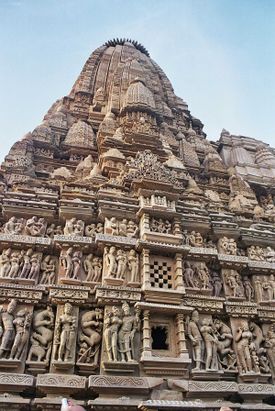 | |
| Criteria | Cultural: i, iii |
| Reference | 240 |
| Inscription | 1986 (10th session) |
Khajuraho (Template:Lang-hi) is a village in the Indian state of Madhya Pradesh, located in Chhatarpur District, about 385 miles (620 kilometres) southeast of Delhi, the capital city of India.
The Khajuraho group of monuments has been listed as a UNESCO World Heritage Site.
One of the most popular tourist destinations in India, Khajuraho has the largest group of medieval Hindu and Jain temples, famous for their erotic sculpture. The name Khajuraho is derived from the Hindi word khajur meaning date palm.
History
The city was once the original capital of the Chandela Rajputs, a Hindu dynasty that ruled this part of India from the 10th to the 12th centuries. The Khajuraho temples were built over a span of 200 years, from 950 to 1150. The Chandela capital was moved to Mahoba after this time, but Khajuraho continued to flourish for some time.'
The whole area was enclosed by a wall with eight gates, each flanked by two golden palm trees. There were originally over 80 Hindu temples, of which only 22 now stand in a reasonable state of preservation, scattered over an area of about 8 square miles (21 km²).
The temples of Khajuraho did undergo destruction by early Muslim invaders between c. 1100-1400 AD as various disfigured statues at these temple complex attest. Today, the temples serve as fine examples of Indian architectural styles that have gained popularity due to their explicit depiction of the traditional way of sexual life during medieval times. They were rediscovered during the late 19th century and the jungles had taken a toll on all of the monuments.
Geography
Khajuraho is located at Lua error: callParserFunction: function "#coordinates" was not found.[1]. It has an average elevation of 283 metres (928 feet).
Demographics
Template:Infobox Indian Jurisdiction
As of 2001[update] India census[2], Khajuraho had a population of 19,282. Males constitute 52% of the population and females 48%. Khajuraho has an average literacy rate of 53%, lower than the national average of 59.5%: male literacy is 62%, and female literacy is 43%. In Khajuraho, 19% of the population is under 6 years of age.
Architecture
The Khajuraho temples, constructed with spiral superstructures, adhere to a northern Indian shikhara temple style and often to a Panchayatana plan or layout. A few of the temples are dedicated to the Jain pantheon and the rest to Hindu deities - to God's Trio, Brahma, Vishnu and Shiva, and various Devi forms, such as the Devi Jagadambi temple. A Panchayatana temple had four subordinate shrines on four corners and the main shrine in the center of the podium, which comprises their base. The temples are grouped into three geographical divisions: western, eastern and southern.
With a graded rise secondary shikharas (spires) cluster to create an appropriate base for the main shikhara over the sanctum. Kandariya Mahadeva, one of the most accomplished temples of the Western group, comprises eighty-four shikharas, the main being 116 feet from the ground level.
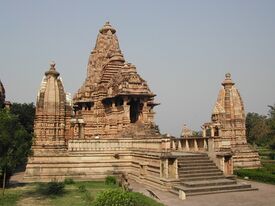
These shikharas -- subordinate and main -- attribute to the Khajuraho temples their unique splendor and special character. With a graded rise of these shikharas from over the ardhamandapa, porch, to mandapa, assembly hall, mahamandapa, principal assembly hall, antarala, vestibule, and garbhagriha, sanctum sanctorum, the Khajuraho temples attain the form and glory of gradually rising Himalayan peaks. These temples of Khajuraho have sculptures that look very realistic and are studied even today.
The Saraswathi temple on the campus of Birla Institute of Technology and Science, Pilani, India is modeled after the Khajuraho temple.
Chronology
The temples have been assigned the following historical sequence by Dr. Kanhaiyalal Agrawal [3].
| Sequence | Modern name | Original Deity | Note |
| 1 | Chausath Yogini | 64 Yoginis | Est 9th c. |
| 2 | Brahma | Vishnu | Eastern group |
| 3 | Lalgun Mahadev | Shiva | Contemp to 2 |
| 4 | Matangeshwar | Siva | In active worship |
| 5 | Varaha | Varaha | |
| 6 | Lakshman | Vaikuntha Vishnu | Lakshavarma Inscription |
| 7 | Parshvanath | Adinath | Pahil inscription 954 AD, Jain Compound |
| 8 | Vishvanath | Shiva | Dhanga inscription Sam 1059 |
| 9 | Devi Jagadambi | Initially Vishnu but today Parvati | |
| 10 | Chitragupta | Surya | |
| 11 | Kandariya Mahadeva | Shiva | Largest |
| 12 | Vamana | Vamana | Eastern Group |
| 13 | Adinath | Jina | Jain compound |
| 14 | Jawari | Vishnu | Eastern group |
| 15 | Chaturbhuja | Vishnu | Southern |
| 16 | Duladev | Shiva | South end |
| 17 | Ghantai | Jina | Only some columns remaining |
Landscape
The Khajuraho temples are now set in a parkland landscape. When India gained independence from Britain in 1947 the landscape setting was semi-desert and scrub. The archaeological park now has something of the character of an English public park, with mown grass, rose beds and ornamental trees. This may be popular with visitors but has no relationship with the historic landscape at the time the temples were built.
The development of landscape archaeology as an academic discipline raises questions concerning the earlier landscape of Khajuraho and the original relationship between the temple complex and the surrounding area. There are no records of what the original landscape might have been, but it is known that a large community of priests used the temple complex and that Indian gardens in the tenth century were predominantly tree gardens. They did not have lawns or herbaceous flowering plants.
The statues and carvings of Khajuraho
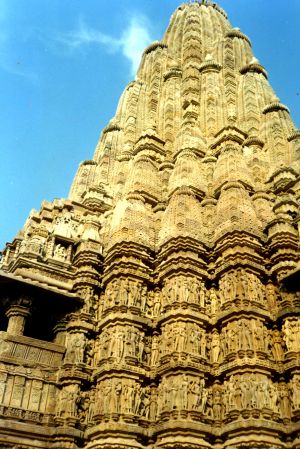
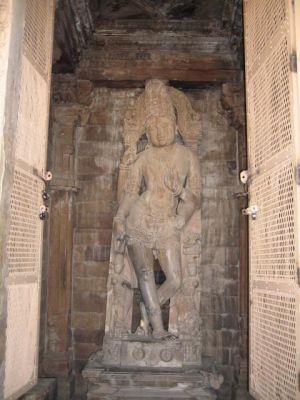
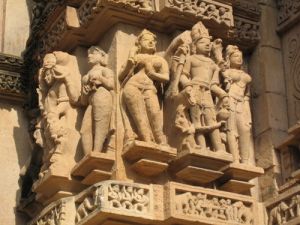
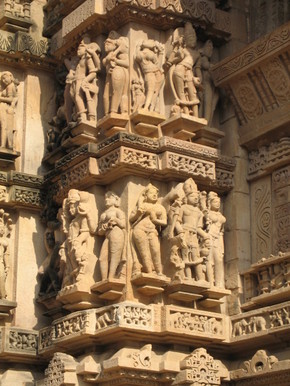
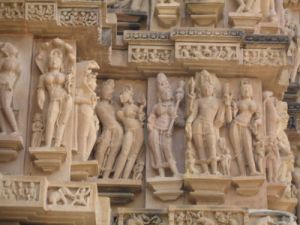
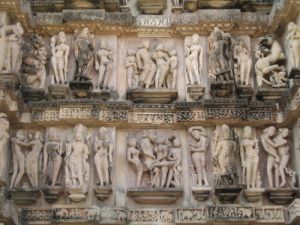
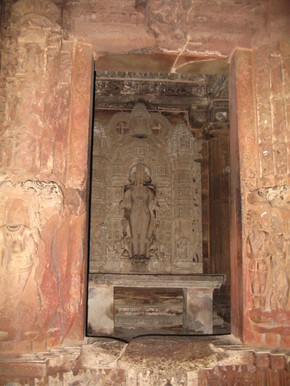
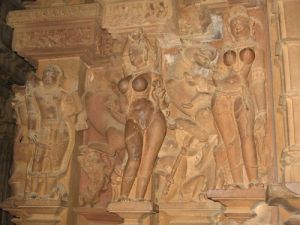
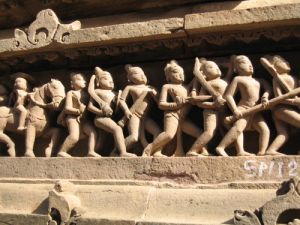
The Khajuraho temples do not contain sexual or erotic art inside the temple or near the deities; however, some external carvings bear erotic art. Also, some of the temples that have two layers of walls have small erotic carvings on the outside of the inner wall. There are many interpretations of the erotic carvings. They portray that, for seeing the deity, one must leave his or her sexual desires outside the temple. They also show that divinity, such as the deities of the temples, is pure like the atman, which is not affected by sexual desires and other characteristics of the physical body. It has been suggested that these suggest tantric sexual practices. Meanwhile, the external curvature and carvings of the temples depict humans, human bodies, and the changes that occur in human bodies, as well as facts of life. Some 10% of the carvings contain sexual themes; those reportedly do not show deities, they show sexual activities between people. The rest depict the everyday life of the common Indian of the time when the carvings were made, and of various activities of other beings. For example, those depictions show women putting on makeup, musicians, potters, farmers, and other folks. Those mundane scenes are all at some distance from the temple deities. A common misconception is that, since the old structures with carvings in Khajuraho are temples, the carvings depict sex between deities.[4]
Another perspective of these carvings is presented by James McConnachie. In his history of the Kamasutra, McConnachie describes the zesty 10% of the Khajuraho sculpture as "the apogee of erotic art":
"Twisting, broad-hipped and high breasted nymphs display their generously contoured
and bejewelled bodies on exquisitely worked exterior wall panels. These fleshy apsaras
run riot across the surface of the stone, putting on make-up, washing their hair, playing games,
dancing, and endlessly knotting and unknotting their girdles....Beside the heavenly nymphs are serried
ranks of griffins, guardian deities and, most notoriously, extravagantly interlocked maithunas, or
lovemaking couples."
While the sexual nature of these carvings have caused the site to be referred to as the Kamasutra temple, they do not illustrate the meticulously described positions. Neither do they express the philosophy of Vatsyayana's famous sutra. As "a strange union of Tantrism and fertility motifs, with a heavy dose of magic" they belie a document which focuses on pleasure rather than procreation. That is, fertility is moot.
The strategically placed sculptures are "symbolical-magical diagrams, or yantras" designed to appease malevolent spirits. This alamkara (ornamentation) expresses sophisticated artistic transcendence over the natural; sexual images imply a virile, thus powerful, ruler.6
Between 950 and 1050, the Chandela monarchs built these temples when the Tantric tradition may have been accepted . In olden days, before the Mughal conquests, when boys lived in hermitages, following brahmacharya until they became men, they could learn about the world and prepare themselves to become householders through examining these sculptures and the worldly desires they depicted.
See also
- Kandariya Mahadeva
- Hemvati
- Kalinjar
- Beejamandal
- Jain temples of Khajuraho
- Temples in Madhya Pradesh
- Temples in India
- List of megalithic sites
References
- ↑ Falling Rain Genomics, Inc - Khajuraho
- ↑ Template:GR
- ↑ Khajuraho, Kanhaiyalal Agrawal, Macmillan India, 1980 (in Hindi)
- ↑ "Khajurajo", liveindia.com
6. McConnachie, James, The Book of Love, the story of the Kamasutra, Metropolitan Press, 2005, pages 46-7.
Further reading
- Phani Kant Mishra, Khajuraho: With Latest Discoveries, Sundeep Prakashan (2001) ISBN 8175741015
- Devangana Desai, "Religious Imagery of Khajuraho," Franco-Indian Research P. Ltd. (1996) ISBN 81-900184-1-8
External links
- UNESCO World Heritage Site Listing
- Khajuraho Temple Sculpture and Carvings Research Project & Photo Exhibition
Photos about Khajuraho in the web site of Italian writer Manuel Olivares : http://www.manuelolivares.it
- gallery of Khajuraho photos
- 100 photos 1280x960 of Khajuraho
- Template:Wikitravel
- Beauty of Khajuraho Temples
- Photos of the Khajuraho temple complex
bn:খাজুরাহ cs:Khadžuráho de:Khajuraho es:Khajuraho eo:Khaĝuraho fr:Khajurâho hi:खजुराहो bpy:খাজুরাহ it:Khajuraho kn:ಖಜುರಾಹೊ ka:ქაჯურაჰო ml:ഖജുരാഹോ nl:Khajuraho new:खजुराहो ja:カジュラーホー pl:Khajuraho pt:Conjunto de Templos de Khajuraho ru:Кхаджурахо fi:Khajuraho sv:Khajuraho te:ఖజురహో వద్ద నిర్మాణ సమూహాలు vi:Khajuraho zh:克久拉霍古跡群
- Pages using infobox UNESCO World Heritage Site with unknown parameters
- Articles containing potentially dated statements from 2001
- Articles with invalid date parameter in template
- All articles containing potentially dated statements
- Pages with broken file links
- Commons category link is locally defined
- Cities and towns in Madhya Pradesh
- Hindu holy cities
- Bundelkhand
- Tourism in Madhya Pradesh
- Chhatarpur